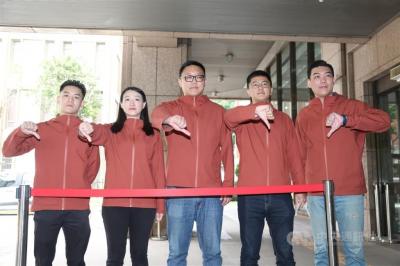The Taiwan Pavilion that was erected at the 2010 Shanghai World Expo is to be officially lit up in Hsinchu City today and is expected to be opened to the public by the end of the year, according to the city government.
The lighting ceremony, along with a concert and a lantern display, is to coincide with the Mid-Autumn Festival, the city government said, adding the event stands to attract 100,000 people.
Pulling in more than 700,000 visitors, the Taiwan Pavilion was one of the most popular features of the six-month expo in Shanghai. It was dismantled soon after the expo closed in late October 2010 and was shipped back to Taiwan for reassembly.
The building was designed by prominent Taiwanese architect Lee Tsu-yuan (李祖原), who also designed Taipei 101.
At its center is a ball 16m in diameter consisting of 1 million LEDs that display various images reflecting Taiwan’s natural beauty and diverse culture. Inside the ball is a 12m-wide screen that shows films of Taiwan. There are to be small changes made to the building so that those who have already visited the pavilion can enjoy it as much as those who have not yet seen it, the city government said.
The pavilion not only highlights Taiwan’s cutting-edge technology, but also showcases some of Taiwan’s best natural and cultural attractions, including Sun Moon Lake (日月潭), Yingge ceramics, rocks from Yushan (玉山) and an infinity pool symbolizing the Pacific Ocean.
Hsinchu purchased the pavilion at a cost of more than NT$450 million (US$15.35 million), with the plan of establishing an industrial innovation park as part of its efforts to boost tourism in the city.
The pavilion is to be one of two main facilities at the Hsinchu Science Park, the largest science park in Taiwan, where there is to be an exhibition hall situated in a renovated warehouse, the city government said.

Taiwan is stepping up plans to create self-sufficient supply chains for combat drones and increase foreign orders from the US to counter China’s numerical superiority, a defense official said on Saturday. Commenting on condition of anonymity, the official said the nation’s armed forces are in agreement with US Admiral Samuel Paparo’s assessment that Taiwan’s military must be prepared to turn the nation’s waters into a “hellscape” for the Chinese People’s Liberation Army (PLA). Paparo, the commander of the US Indo-Pacific Command, reiterated the concept during a Congressional hearing in Washington on Wednesday. He first coined the term in a security conference last

Prosecutors today declined to say who was questioned regarding alleged forgery on petitions to recall Democratic Progressive Party (DPP) legislators, after Chinese-language media earlier reported that members of the Chinese Nationalist Party (KMT) Youth League were brought in for questioning. The Ministry of Justice Investigation Bureau confirmed that two people had been questioned, but did not disclose any further information about the ongoing investigation. KMT Youth League members Lee Hsiao-liang (李孝亮) and Liu Szu-yin (劉思吟) — who are leading the effort to recall DPP caucus chief executive Rosalia Wu (吳思瑤) and Legislator Wu Pei-yi (吳沛憶) — both posted on Facebook saying: “I

The Ministry of Economic Affairs has fined Taobao NT$1.2 million (US$36,912) for advertisements that exceed its approved business scope, requiring the Chinese e-commerce platform to make corrections in the first half of this year or its license may be revoked. Lawmakers have called for stricter enforcement of Chinese e-commerce platforms and measures to prevent China from laundering its goods through Taiwan in response to US President Donald Trump’s heavy tariffs on China. The Legislative Yuan’s Finance Committee met today to discuss policies to prevent China from dumping goods in Taiwan, inviting government agencies to report. Democratic Progressive Party Legislator Kuo Kuo-wen (郭國文) said

The Ministry of Economic Affairs has fined Taobao NT$1.2 million (US$36,900) for advertisements that exceeded its approved business scope and ordered the Chinese e-commerce platform to make corrections in the first half of this year or its license would be revoked. Lawmakers have called for stricter supervision of Chinese e-commerce platforms and more stringent measures to prevent China from laundering its goods through Taiwan as US President Donald Trump’s administration cracks down on origin laundering. The legislature’s Finance Committee yesterday met to discuss policies to prevent China from dumping goods in Taiwan, inviting government agencies to report on the matter. Democratic Progressive Party